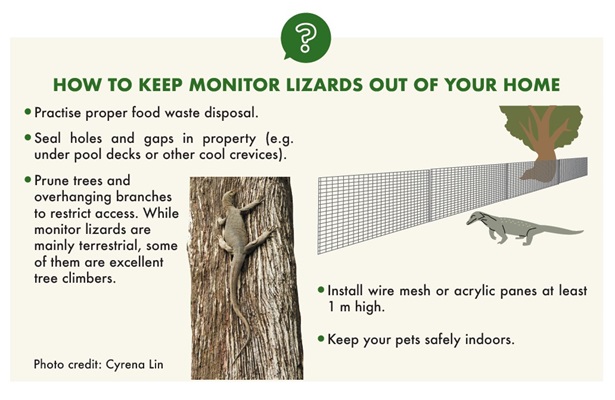What are they?
The most common monitor lizard among the three found in Singapore is the Malayan water monitor (Varanus salvator) that can grow up to 3m long. The other two species, the clouded monitor lizard (Varanus nebulous), and the rarest Dumeril’s monitor (Varanus dumerilii) can grow to a length of 1 to 1.5m. Monitor lizards are mostly carnivorous; some also scavenge on carrion. It can be found in forests, mangrove swamps, and even man-made canals!


Malayan Water Monitor Lizard & Clouded Monitor Lizard
Photos by Nick Baker


Dumeril’s Monitor Lizard & Dumeril’s Monitor Lizard (juvenile)
Photos by Michael Cota
Important Ecological Roles
Control of prey population
Monitor lizards feed on a huge variety of food types (eg. insects, crabs, snakes, fish, etc); they control the population of their prey, and in turn are a source of food to larger predators (eg. crocodiles).
Keep habitat clean
They also play an important role as scavengers in biomass decomposition and recycling.
Common Concerns
The monitor’s saliva contains over 50 bacteria that infect and kill their prey slowly. Is this true?
The carrion meat that get stuck in the monitor’s teeth are teeming with bacteria that can cause infections in the bite wound. However, the main cause of death of preys is the venom secreted by the monitor.
Are monitor lizards venomous?
Contrary to previous beliefs, most lizards do possess glands that secrete venom. While the monitor uses its venom to kill its small preys (symptoms include rapid swelling, drop in blood pressure, and blood clot inhibition), it has a relatively mild effect on humans.
Are they dangerous?
They are naturally shy and would rather stay away from humans. Like most wild animals, they do not attack unless provoked. As long as you keep your distance and leave them alone, you will be fine.
Conservation
In Singapore, it is illegal under the Wildlife Act to remove wild animals, including monitor lizards, from the wild. Those found in nature reserves and other areas managed by NParks are also protected by the Parks and Trees Act 2005.
Poaching of monitor lizards exists in Singapore. However, they are often not brought to the attention of local authorities.
How can I help?
- If you witness any illegal trading or poaching:
- Collect information. Take photos or video evidences of the traps, animals, poachers, and/or their vehicle license plate number.
- Call NParks' Animal Response Centre at 1800-476-1600.
Do not buy any monitor lizard products, such as meat and skin products.
- Raise awareness by sharing with your friends and family about the threats to monitor lizards, and what can they do to help.
What to do when I encounter a monitor lizard?
- Do not be alarmed. These animals are shy and will not attack humans unless provoked or cornered.
- Do not touch, chase or corner them as they may attack in defence. You are advised to leave them alone. It is fine to observe them from afar.
- Seek medical attention immediately if (in a rare event) you are bitten. Although monitor lizards do secrete venom, it is not fatal to humans. The main cause for concern would be bacterial infection from the bite.
How to keep monitor lizards out of your home

If you have further queries, please contact us through our online feedback form at https://www.avs.gov.sg/feedback.
References from Singapore Biodiversity Encyclopedia (2011) and www.naturia.per.sg